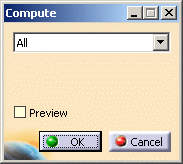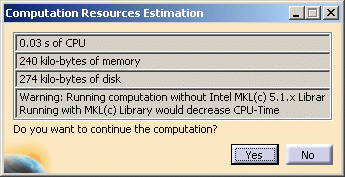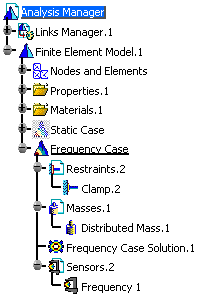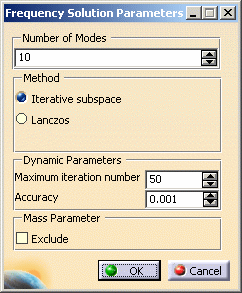This task shows how to compute a Frequency Case Solution.
The Compute command is most often applied to Analysis Case Solutions (which are particular types of objects sets). In this case, it generates the analysis case solution, along with partial results for all objects involved in the definition of the Analysis Case.
The primary Frequency Solution Computation result consists of a set of frequencies and associated modal vibration shape vectors whose components represent the values of the system dof for various vibration modes.
The program can compute simultaneously several Solution objects sets, with optimal parallel computation whenever applicable.
Avoid having CATAnalysis documents automatically saved.
To know more, refer to Computing
Objects Sets.
Open the sample56.CATAnalysis document from the samples directory for this task.
-
Click Compute
 .
.The Compute dialog box appears.
For more details about the Compute dialog box, refer to Computing Object Sets. -
Select the All option.

In this case, the program will compute by default all objects up to (and including) the Frequency Case Solution in the analysis features tree.
-
Select the Preview check box.
-
Click OK.
The estimations are displayed in the Computation Resources Estimation dialog box. You can proceed with the computation or choose to postpone it.

-
Click Yes to launch the computation.
The Computation Status dialog box provides a series of status messages (Meshing, Factorization, Solution) that inform you of the degree of advancement of the computation process.
The Frequency Analysis Solution is computed and can be visualized.
Upon successful completion of the computation, the FE mesh is visualized on your part, and the status of all objects in the analysis features tree up to the Frequency Case Solution objects set is changed to valid. You can now:
- analyze the report of the computation
- visualize images for various results

Products Available in Analysis Workbench
![]() The ELFINI Structural Analysis product offers the following
additional feature:
The ELFINI Structural Analysis product offers the following
additional feature:
- If several Frequency Analysis Cases have been defined, you can compute them simultaneously by following the same procedure. You can also compute only a selection of cases by selecting Analysis Cases Solution Selection. You can then specify the cases in the Compute dialog box.
- You can compute vibration modes either for the free system or for the system subjected to supports. In the first case there are no restraints so your Analysis Case must contain no Restraints objects set.
- To display CPU time and memory requirement estimates prior to launching any computations, activate the Estimates switch in the Update dialog box.
- The status and results of intermediate pre-processor computations necessary to perform this translation are reported in HTML format. For more detail see the basic global Report capability .
- The Definition parameters of an Analysis Case, (available, in the ELFINI Structural Analysis product, in the New Case dialog box at the time of a Case Insertion) cannot be modified once the Case has been created. These must not be confused with the Computation parameters of a Case Solution, which are proposed by default at creation, and are editable afterwards.
- To edit the default values of the Computation parameters of a Case
Solution, double-click the Solution objects set in the analysis
specification tree (or right-click, then click .Object >
Definition ) to display the Frequency Solution Parameters dialog
box.

To know more about the Static Solution Parameters dialog box, refer to Inserting a Frequency Case.
![]() The ELFINI product offers the following additional features on a
Frequency Case Solution objects set:
The ELFINI product offers the following additional features on a
Frequency Case Solution objects set:
- Generate Image: proposes to generate the various images
available along with the Static Solution objects set. The image can be
edited to include part or all of the options available.
Right-click the Mass object and then select Generate Image
 (on the condition you previously computed a solution).
(on the condition you previously computed a solution).The Image Generation dialog box appears. You can select images by clicking them in the list.
- Report: the global status and results of all computations
are reported in HTML format.
Click Generate Report
 (on the condition you previously computed a solution).
(on the condition you previously computed a solution).The .html partial report file is displayed. It contains a summary of the modal computation results, including the values of the rigid body modal participation factors for the computed modes.
![]()